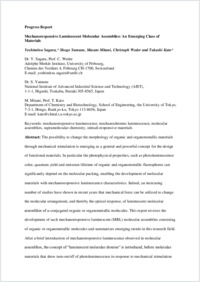Mechanoresponsive Luminescent Molecular Assemblies : An Emerging Class of Materials
- Sagara, Yoshimitsu Adolphe Merkle Institute, University of Fribourg, Switzerland
- Yamane, Shogo National Institute of Advanced Industrial Science and Technology, Tsukuba, Ibaraki, Japan
- Mitani, Masato Department of Chemistry and Biotechnology, School of Engineering, the University of Tokyo, Japan
- Weder, Christoph Adolphe Merkle Institute, University of Fribourg, Switzerland
- Kato, Takashi Department of Chemistry and Biotechnology, School of Engineering, the University of Tokyo, Japan
-
2015
Published in:
- Advanced Materials. - Wiley. - 2015, vol. 28, no. 6, p. 1073-1095
mechanochromic luminescence
mechanoresponsive luminescence
molecular assemblies
stimuli-responsive materials
supramolecular chemistry
English
The possibility to change the molecular assembled structures of organic and organometallic materials through mechanical stimulation is emerging as a general and powerful concept for the design of functional materials. In particular, the photophysical properties such as photoluminescence color, quantum yield, and emission lifetime of organic and organometallic fluorophores can significantly depend on the molecular packing, enabling the development of molecular materials with mechanoresponsive luminescence characteristics. Indeed, an increasing number of studies have shown in recent years that mechanical force can be utilized to change the molecular arrangement, and thereby the optical response, of luminescent molecular assemblies of π-conjugated organic or organometallic molecules. Here, the development of such mechanoresponsive luminescent (MRL) molecular assemblies consisting of organic or organometallic molecules is reviewed and emerging trends in this research field are summarized. After a brief introduction of mechanoresponsive luminescence observed in molecular assemblies, the concept of “luminescent molecular domino” is introduced, before molecular materials that show turn-on/off of photoluminescence in response to mechanical stimulation are reviewed. Mechanically stimulated multicolor changes and water-soluble MRL materials are also highlighted and approaches that combine the concept of MRL molecular assemblies with other materials types are presented in the last part of this progress report.
- Faculty
- Faculté des sciences et de médecine
- Department
- AMI - Chimie des polymères et matériaux
- Language
-
- English
- Classification
- Chemistry
- License
-
License undefined
- Identifiers
-
- RERO DOC 258950
- DOI 10.1002/adma.201502589
- Persistent URL
- https://folia.unifr.ch/unifr/documents/304675
Statistics
Document views: 135
File downloads:
- Texte intégral: 600
